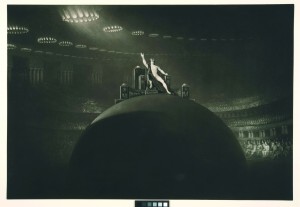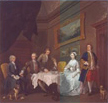For those of you who have already made it to John Martin: Apocalypse, you may have been surprised to see a large piece of furniture included in the show. It was probably made by Martin between 1835 and 1840 – and not particularly well to say the least. Essentially, it’s two pieces of furniture cobbled together with doors that don’t close properly and gaping holes at the back: Martin was certainly no Chippendale!

© Tyne & Wear Archives & Museums/Laing Art Gallery
On one side a series of drawers are labelled with his major paintings, and on the other side drawers are labelled with many of his engineering projects.

© Tyne & Wear Archives & Museums/Laing Art Gallery
On the front another set of drawers identify the various awards and letters he had received from institutions and monarchs. It is a prominent self-congratulatory and public statement, announcing that by this stage in his career, Martin had ‘made it’.

© Tyne & Wear Archives & Museums/Laing Art Gallery (Click to view larger version)
This would have been an important declaration for Martin to make when we consider his humble beginnings. He was born in a one-roomed cottage in Haydon Bridge in Northumberland and began his artistic career as a coach painter, not a fine artist. Throughout his career he struggled to gain recognition from the art elite and was never considered a serious high-minded and intellectual artist. He was often branded with the word ‘populist’, never achieved the distinction of being a Royal Academician in Britain, and was regularly derided by the art critics. Yet, his art was loved by millions; barriers had to be erected in front of his paintings when they were exhibited due to the crush of people, and his prints could be found framed on the walls of many houses up and down the country and as far afield as Australia.
The cabinet cannot simply be seen as serving a practical purpose in storing his working papers: it tells us so much more about John Martin and the way in which he perceived himself, but more importantly, how he wanted others to perceive him.
The bright red fabric, the gold ornament and glossy black paint were intended to make visitors stop and look – to admire the display of medals bestowed upon Martin by foreign monarchs, and note the letters he had received from the aristocracy, including none other than Queen Victoria herself! Every visitor who went to Martin’s house would have seen the cabinet in his drawing room; it wasn’t hidden away in a private part of the house, or merely serving as storage in his studio. This was a definite public statement of Martin’s achievements and reputation, a ‘3D CV’! Today we might cringe at such a display of self-congratulation, and perhaps people did then too? We also know that in the entrance hall to Martin’s house a sequence of plaster busts of Queen Victoria, King Leopold of the Belgians and even one of John Martin greeted the visitor! Was John Martin, the lad from Northumberland going a bit too far to make his connections known? Was it this sort of crass promotion that induced a certain level of snobbery in the art elite of the day?
Or was the achievement of aristocratic and royal patronage so crucial to the success of an artist in the nineteenth century that it needed to be made public? And can we say that things have changed today? If an artist doesn’t get their work exhibited in major exhibitions, win the Turner Prize, be collected by Saatchi, can they be considered serious artists? What is it that determines success and should being thought of as ‘popular’ undermine an artist’s reputation? What do you think Martin was trying to tell us by building his big black cabinet?














What does art mean to you?
You can also join the debate on
Facebook
Twitter
Youtube